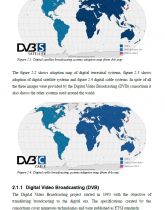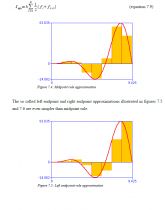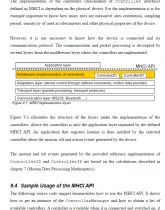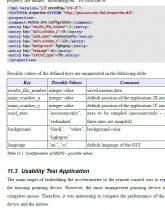Hľadaj
Zobraz:
Univerzity
Kategórie
Rozšírené vyhľadávanie
45 146
projektov
Use of hand motion for control of digital television receiver
| Prípona |
Typ diplomová práca |
Stiahnuté 0 x |
| Veľkosť 2,5 MB |
Jazyk anglický |
ID projektu 12354 |
| Posledná úprava 18.10.2019 |
Zobrazené 1 448 x |
Autor: - |
 Zdieľaj na Facebooku
Zdieľaj na Facebooku |
||
| Detaily projektu | ||
- cena:
35 Kreditov - kvalita:
92,3% -
Stiahni
- Pridaj na porovnanie
- Univerzita:Žilinská univerzita v Žiline
- Fakulta:Elektrotechnická fakulta
- Kategória:Technika » Siete a komunikácia
- Predmet:-
- Študijný program:-
- Ročník:5. ročník
- Formát:PDF dokument (.pdf)
- Rozsah A4:131 strán
Digitalization of television broadcasting brings new possibilities for TV receiver usage.
However, new features of the TV receiver also increase the complexity of its control.
Results of research conducted in Great Britain show that the majority of viewers
perceive the systems of digital and interactive television being too complex and
difficult to use.
The objective of this work is to propose a new concept of TV receiver control that will be suitable for emerging interactive television, but will preserve the easiness-to-use comparable to analogue receivers. The target was achieved by augmenting the traditional remote control to be able to measure and analyse its motion. The measurement of motion is realized by an embedded accelerometer. The advantage of employing an accelerometer is simpler processing of the collected data compared e.g. to image processing (if the motion data were obtained from a system of cameras).
The objective of this work is to propose a new concept of TV receiver control that will be suitable for emerging interactive television, but will preserve the easiness-to-use comparable to analogue receivers. The target was achieved by augmenting the traditional remote control to be able to measure and analyse its motion. The measurement of motion is realized by an embedded accelerometer. The advantage of employing an accelerometer is simpler processing of the collected data compared e.g. to image processing (if the motion data were obtained from a system of cameras).
Kľúčové slová:
digitalization
television broadcasting
digital television receiver
computer interaction
controller
complexity
accelerometer
Obsah:
- 1 Introduction -23-
1.1 Objectives of the Work -24-
1.2 Sequence of Steps -25-
1.3 Structure of the Paper -27-
2 Digital and Interactive Television Receiver -28-
2.1 Digital Transmission of Television Signal -28-
2.1.1 Digital Video Broadcasting (DVB) -31-
2.1.2 Integrated Services Digital Broadcasting (ISDB) -32-
2.1.3 Advanced Television Systems Committee (ATSC) -32-
2.2 Interactive Television Platforms -33-
2.2.1 Multimedia and Hypermedia Expert Group (MHEG) -35-
2.2.2 Multimedia Home Platform (MHP) -35-
2.2.3 Open Cable Application Platform (OCAP) -37-
2.2.4 DTV Application Software Environment (DASE) -37-
2.2.5 Globally Executable MHP (GEM) -38-
2.2.6 Advanced Common Application Platform (ACAP) -38-
3 Interactive Television Viewer Experience -40-
3.1 Interactive Television is Perceived Being Hard to Use -40-
3.2 Interactive Television Compared to Personal Computer -41-
3.3 Issues that Make the Interactive Television Difficult to Use -42-
4 Proposed Concept of Interactive TV Control -43-
4.1 Requirements and Constraints -44-
4.2 Proposed Motion Control -45-
4.3 Hand Motion Tracking -45-
4.4 Thesis to be Examined and Clarified -47-
4.5 Comparison of Motion Control and Computer Mouse -48-
4.6 Opinion Poll about Motion Controlled Television -51-
4.6.1 Conducting the Study -51-
4.6.2 Results -52-
5 Motion Control Prototype Hardware -55-
5.1 Accelerometer Theoretically -55-
5.2 Available Accelerometers -58-
5.3 General Requirements -60-
5.4 ADXL202, ADXL210, ADXL213 Dual Axis Accelerometers -61-
5.5 Power Supply -63-
5.6 Four ADXL Accelerometers Evaluation Board -64-
6 Embedded Software -67-
6.1 Development Tools -67-
6.2 Features -67-
6.3 State Diagram -67-
6.4 Communication Protocol -68-
6.5 Device Control -69-
7 Motion Data Processing Mathematics -70-
7.1 Samples Obtained from the Motion Control -70-
7.2 Numerical Differentiation of Acceleration -71-
7.3 Numerical Integration -71-
7.4 Velocity -76-
7.5 Displacement -76-
7.6 Tilt -77-
8 Data Processing and Analysis Software -80-
8.1 Development Tools and Used Libraries -80-
8.2 Accelerometer Terminal -80-
8.3 Saving the Captured Motion Data -81-
8.4 Displaying the Motion Data -81-
9 Motion Human-Computer Interaction Java API -83-
9.1 Requirements -83-
9.2 Design -83-
9.3 Implementation -86-
9.4 Sample Usage of the MHCI API -86-
10 „TVFace“ Visual Component Toolkit for Digital Television Receivers -88-
10.1 Requirements -88-
10.2 List of the Visual Components -89-
10.3 Structure of the Toolkit -90-
10.4 Sample Application -91-
11 EPG Controlled by Motion -93-
11.1 The Intentions with the MEPG -93-
11.2 The Implemented MEPG -93-
11.3 Usability Test Application -95-
11.4 Playing Breakout -97-
12 Analysis of Measured Data -99-
12.1 Accuracy of the Device -99-
12.2 Basic Motions -100-
12.2.1 Translation Right -100-
12.2.2 Translation Left -103-
12.2.3 Translation Up -104-
12.2.4 Translation Down -108-
12.3 Tilt -110-
12.4 Subtracting Gravitation -111-
12.5 Free Fall Detection -112-
12.6 Usability Research -114-
12.6.1 Procedure -114-
12.6.2 Results -114-
12.7 Recommendations for Motion Control Design -118-
13 Conclusion -119-
Zdroje:
- Štefl D.: MHP Application Manager Design and Implementation for PC, Diploma thesis, University of West Bohemia, Faculty of Electrical Engineering, Pilsen, May 2001
- Štefl D.: Introduction to DVB-MHP Application Development, Electrotechnics and Informatics 2002, October 2002, ISBN 80-7082-904-4
- Štefl D.: Využití pohybu a gest ruky pro ovládání televizního přijímače, paper for doctoral state exam, University of West Bohemia, Faculty of Electrical Engineering, Pilsen, August 2003
- Štefl D.: Vývoj aplikací pro platformu MHP, EurOpen 2003, September 2003, ISBN 80-86583-04-X
- Štefl D.: Interaktivní digitální televize, Chip, Volume 5/05, May 2005
- Štefl D.: Hůlka Harryho Pottera, Chip, Volume 9/05, September 2005
- Štefl D.: Televize pro mobily, Chip, Volume 10/05, October 2005
- Štefl D.: Tilting the Remote, DVB-Scene, Issue 20, to be published November 2006
- Štefl D., Tetour J.: Aktualizace softwaru přijímačů DVB-T, Sdělovací technika, to be published January 2007
- Štefl D.: Kouzelnická hůlka Harryho Pottera aneb dálkové ovládání iTV, Sdělovací technika, to be published February 2007








